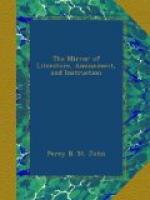Jennie Deans.—An unknown correspondent (a lady) favoured me with the history of the upright and high principled female, whom, in the “Heart of Mid Lothian,” I have termed Jeanie Deans. The circumstance of her refusing to save her sister’s life by an act of perjury, and undertaking a pilgrimage to London to obtain her pardon, are both represented as true by my fair and obliging correspondent; and they led me to consider the possibility of rendering a fictitious personage interesting by mere dignity of mind and rectitude of principle, assisted by unpretending good sense and temper, without any of the beauty, grace, talent, accomplishment, and wit, to which a heroine of romance is supposed to have a prescriptive right. If the portrait was received with interest by the public, I am conscious how much it was owing to the truth and force of the original sketch, which I regret that I am unable to present to the public, as it was written with much feeling and spirit.
Bride of Lammermoor.—The terrible catastrophe of the Bride of Lammermoor actually occurred in a Scottish family of rank. The female relative, by whom the melancholy tale was communicated to me many years since, was a near connexion of the family in which the event happened, and always told it with an appearance of melancholy mystery, which enhanced the interest. She had known, in her youth, the brother who rode before the unhappy victim to the fatal altar, who, though then a mere boy, and occupied almost entirely with the gallantry of his own appearance in the bridal procession, could not but remark that the hand of his sister was moist, and cold as that of a statue. It is unnecessary further to withdraw the veil from this scene of family distress, nor, although it occurred more than a hundred years since, might it be altogether agreeable to the representatives of the families concerned in the narrative. It may be proper to say that the events are imitated; but I had neither the means nor intention of copying the manners, or tracing the characters, of the persons concerned in the real story.
The Antiquary.—The character of Jonathan Oldbuck, in the “Antiquary,” was partly founded on that of an old friend of my youth, to whom I am indebted for introducing me to Shakspeare, and other invaluable favours; but I thought I had so completely disguised the likeness, that it could not be recognised by any one now alive. I was mistaken, however, and indeed had endangered what I desired should be considered as a secret; for I afterwards learned that a highly respectable gentleman, one of the few surviving friends of my father, and an acute critic, had said, upon the appearance of the work, that he was now convinced who was the author of it, as he recognised, in the “Antiquary,” traces of the character of a very intimate friend of my father’s family.
Waverley.—The sort of exchange of gallantry between the Baron of Bradwardine and Col. Talbot is a literal fact. [For the real circumstances of the anecdote, we must refer our readers to the “Introduction” itself. It was communicated to Sir Walter by the late Lord Kinedder.]




